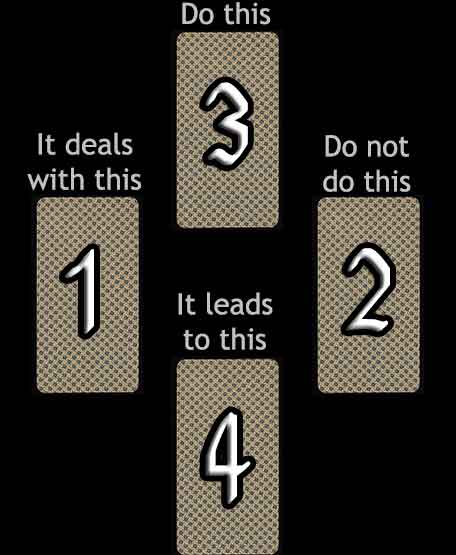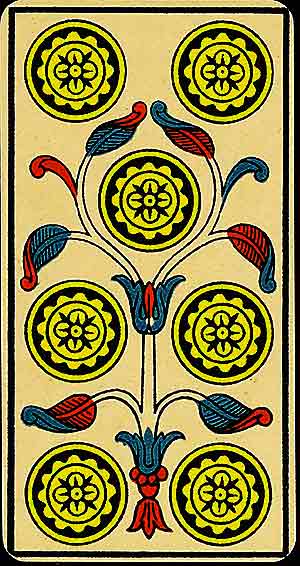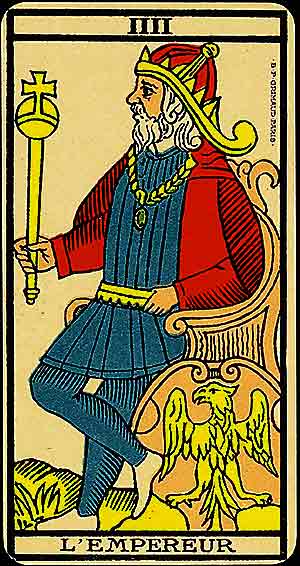Cross Spread

Difficulty: Easy
The Cross Spread is good for questions asking for advice. It can also be used to determine the meaning of a confusing card from a previous reading, or for that matter, to shed light on other points of confusion.
In questions asking advice, this tarot spread is self-explanatory. The main thing is to determine the difference between cards #2 and #3. #1 is the topic and #4 is the result.
In questions regarding confusion, such as: "What was the meaning of Card (X) in the last spread?" the main thing is also to determine the difference between cards #2 and #3. In this case, #2 will show what the card was not referring to, and Card #3 will show what was really meant. Card #1 is the topic and #4 represents the purpose it serves.
Your Cross Reading
DO This Seven of Coins |
||
It Deals with This Deuce of Batons |
Do NOT Do This Four of Swords |
|
It Leads to This IIII – The Emperor (L'Empereur) |

It Deals with This
Deuce of Batons
The Deuce of Batons represents planning and the initial stages of action. It symbolises the tension between potential paths and the courage required to step forward.
Symbolism: Two batons intersect, adorned with foliage that hints at growth and duality. The symmetry of the design reflects stability but also implies the need for decision-making.
In Relationships: A partnership at a crossroads, where mutual goals must be clarified.
In Work: Strategic planning and weighing options for growth. It's a call to act decisively.
Spiritually: The card signifies a moment of reflection, urging you to align choices with your higher purpose.
When ill-dignified: Indecision, hesitation, or lack of direction. It warns against delaying action because of fear of failure.

Do NOT Do This
Four of Swords
The Four of Swords symbolises rest, recuperation, and mental clarity achieved through stillness. It reflects the need for pause before taking further action.
Symbolism: Four curved swords form an oval frame, with interwoven bindings at the top and bottom, creating a sense of structure and containment. At the centre of the composition, a single blooming flower emerges, symbolising peace, recovery, and renewal. The flowing curves and woven intersections suggest a more organic approach to rest and contemplation. The imagery highlights the importance of finding harmony within stillness, reinforcing the idea that mental clarity arises when balance and inner peace are embraced.
In Relationships: A period of emotional detachment or taking space to reflect on a relationship's direction.
In Work: A time for rest or strategic planning. Progress will come after regrouping and gathering strength.
Spiritually: The card invites retreat into meditation or introspection to realign with higher truths.
When ill-dignified: Stagnation, resistance to rest, or avoidance of necessary reflection. It warns against burnout or neglecting self-care.

DO This
Seven of Coins
The Seven of Coins signifies patience, evaluation, and long-term planning. It reflects the need to assess progress and make adjustments for future growth.
Symbolism: Seven coins are arranged in an uneven pattern, with budding leaves suggesting slow but steady growth. The design emphasises reflection and the rewards of cultivation.
In Relationships: A relationship enters a reflective phase, where mutual effort and commitment are assessed.
In Work: Progress may feel slow, but perseverance and thoughtful adjustments will yield results.
Spiritually: The card urges the seeker to remain patient and trust the process of spiritual growth.
When ill-dignified: Impatience, dissatisfaction, or poor planning. It warns against abandoning efforts prematurely or ignoring the need for evaluation.

It Leads to This
IIII – The Emperor (L'Empereur)
The Emperor embodies structure, authority, and the power of order. He is the architect of stability, encouraging discipline and leadership in the material world.
Symbolism: The Emperor's throne and square-shaped setting symbolise structure and the solid foundation of his rulership. The sceptre and orb he holds reflect his control over earthly domains. His gaze is firm and unyielding, emphasising responsibility and focus.
In Relationships: Stability, loyalty, and shared goals define relationships under the Emperor's influence. It may also indicate a partner with strong authoritative traits.
In Work: Success through organisation, discipline, and strategic planning. Leadership is both a gift and a responsibility.
Spiritually: The Emperor teaches the balance between setting boundaries and allowing the divine to flow within the constraints of the physical world.
When ill-dignified: Rigidity, stubbornness, or misuse of power. It warns against being controlling or dismissive of emotional needs.